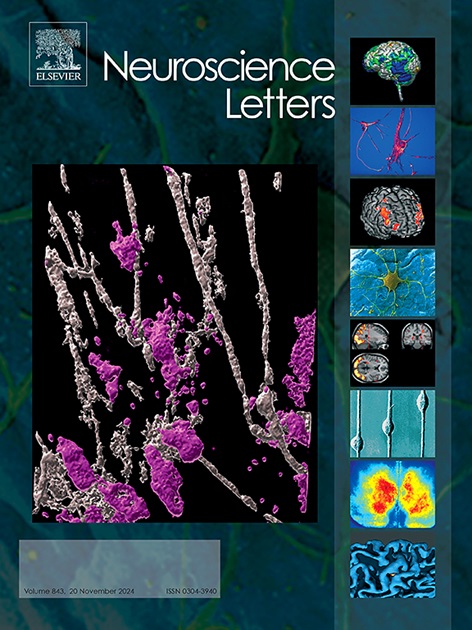评估促髓鞘形成药物对遗传性白质脑病斑马鱼模型运动功能和髓鞘形成的影响。
IF 2
4区 医学
Q3 NEUROSCIENCES
引用次数: 0
摘要
遗传性白质脑病(gLE)是一种影响中枢神经系统的白质紊乱,可导致髓鞘发育迟缓、运动退化以及认知、视觉和听力障碍。其临床变异性使诊断具有挑战性。一种新的纯合错义突变,液泡蛋白分选11 (vps11)中的p.Cys846Gly,与人类婴儿发病的gLE有关。建立了斑马鱼vps11突变体模型来复制le样的髓鞘发育低下和感觉运动缺陷。本研究探讨了促髓鞘形成药物Clemastine对vps11基因突变斑马鱼幼鱼运动功能和髓鞘形成的影响。我们在斑马鱼幼鱼受精后(dpf) 2至4 天的早期神经系统发育的关键时期暴露于这种药物,并在7 dpf时评估视觉运动反应。虽然Clemastine显著增加了少突胶质细胞的数量,但它不能改善vps11突变体的视觉运动功能。这些发现表明,增加少突胶质细胞数量并不一定会导致vps11突变体行为反应的改善。本文章由计算机程序翻译,如有差异,请以英文原文为准。
Evaluating the effects of pro-myelinating drugs on motor function and myelination in a zebrafish model of genetic leukoencephalopathy
Genetic leukoencephalopathy (gLE) is a white matter disorder affecting the central nervous system, causing hypomyelination, developmental delays, motor deterioration, and cognitive, visual, and hearing impairments. Its clinical variability makes diagnosis challenging. A novel homozygous missense mutation, p.Cys846Gly in VACUOLAR PROTEIN SORTING 11 (VPS11), has been linked to infantile-onset gLE in humans. A zebrafish vps11 mutant model was developed to replicate gLE-like hypomyelination and sensorimotor deficits. This study investigates the effects of Clemastine, a pro-myelinating drug, on motor function and myelination in zebrafish larvae with mutations in the vps11 gene. We exposed zebrafish larvae to this drug during a critical period of early nervous system development, from 2 to 4 days post-fertilization (dpf), and assessed visuomotor responses at 7 dpf. Although Clemastine significantly increased the number of oligodendrocytes, it failed to improve visuomotor function in vps11 mutants. These findings imply that increasing oligodendrocyte numbers does not necessarily result in improved behavioral responses in vps11 mutants.
求助全文
通过发布文献求助,成功后即可免费获取论文全文。
去求助
来源期刊

Neuroscience Letters
医学-神经科学
CiteScore
5.20
自引率
0.00%
发文量
408
审稿时长
50 days
期刊介绍:
Neuroscience Letters is devoted to the rapid publication of short, high-quality papers of interest to the broad community of neuroscientists. Only papers which will make a significant addition to the literature in the field will be published. Papers in all areas of neuroscience - molecular, cellular, developmental, systems, behavioral and cognitive, as well as computational - will be considered for publication. Submission of laboratory investigations that shed light on disease mechanisms is encouraged. Special Issues, edited by Guest Editors to cover new and rapidly-moving areas, will include invited mini-reviews. Occasional mini-reviews in especially timely areas will be considered for publication, without invitation, outside of Special Issues; these un-solicited mini-reviews can be submitted without invitation but must be of very high quality. Clinical studies will also be published if they provide new information about organization or actions of the nervous system, or provide new insights into the neurobiology of disease. NSL does not publish case reports.
 求助内容:
求助内容: 应助结果提醒方式:
应助结果提醒方式:


